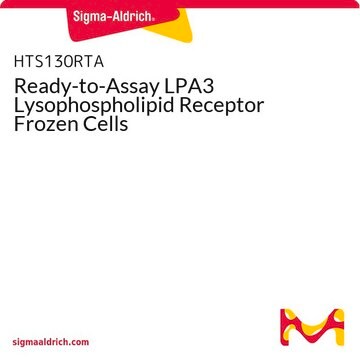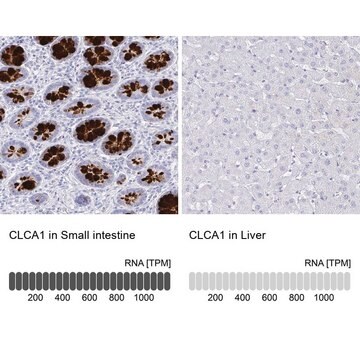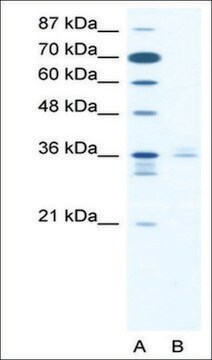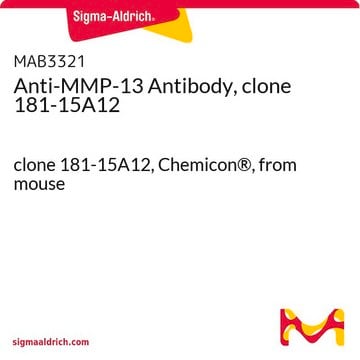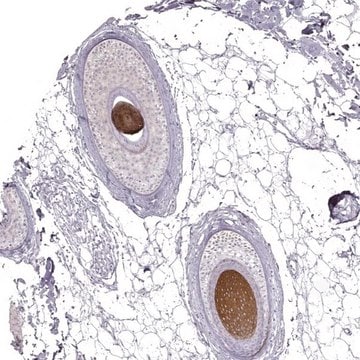HTS207RTA
Ready-to-Assay LPA2 Lysophospholipid Receptor Frozen Cells
Human
Iniciar sesiónpara Ver la Fijación de precios por contrato y de la organización
About This Item
Código UNSPSC:
41106514
eCl@ss:
32011203
NACRES:
NA.84
Productos recomendados
Nombre del producto
Ready-to-Assay LPA2 Lysophospholipid Receptor Frozen Cells,
origen biológico
human
fabricante / nombre comercial
Ready-to-Assay
técnicas
calcium flux assay: suitable
Nº de acceso NCBI
método de detección
fluorometric
Descripción general
Millipore′s Ready-to-Assay GPCR frozen cells are designed for simple, rapid calcium assays with no requirement for intensive cell culturing. Millipore has optimized the freezing conditions to provide cells with high viability and functionality post-thaw. The user simply thaws the cells and resuspends them in media, dispenses cell suspension into assay plates and, following over night recovery, assays for calcium response.
Lysophosphatidic acid (LPA) is a lysophospholipid produced by activated platelets that inhibits adenylate cyclase and stimulates DNA synthesis, changes in cell morphology, and increases in intracellular calcium in a variety of cultured mammalian cells. A family of three GPCRs, LPA1, LPA2, and LPA3, mediates the biological effects of LPA (Contos et al., 2000). LPA2 is widely expressed, with particularly notable expression in helper T Cells (Huang et al.) LPA2 upregulation has been demonstrated in multiple cancer cells, including colon and ovarian cancer (Yun et al.). LPA2 couples to multiple signaling cascades through Gq Gi/o and G12/13, mediating inhibition of adenyl cyclase, inositol phosphate turnover, calcium flux and cell migration Millipore′s cloned human LPA2 expressing cell line is made in the Chem-1 host, which supports high levels of recombinant LPA2 expression on the cell surface and contains high levels of the promiscuous G protein Gα15 to couple the receptor to the calcium signaling pathway. Thus, the cell line is an ideal tool for screening for agonists, antagonists and modulators at LPA2.
Lysophosphatidic acid (LPA) is a lysophospholipid produced by activated platelets that inhibits adenylate cyclase and stimulates DNA synthesis, changes in cell morphology, and increases in intracellular calcium in a variety of cultured mammalian cells. A family of three GPCRs, LPA1, LPA2, and LPA3, mediates the biological effects of LPA (Contos et al., 2000). LPA2 is widely expressed, with particularly notable expression in helper T Cells (Huang et al.) LPA2 upregulation has been demonstrated in multiple cancer cells, including colon and ovarian cancer (Yun et al.). LPA2 couples to multiple signaling cascades through Gq Gi/o and G12/13, mediating inhibition of adenyl cyclase, inositol phosphate turnover, calcium flux and cell migration Millipore′s cloned human LPA2 expressing cell line is made in the Chem-1 host, which supports high levels of recombinant LPA2 expression on the cell surface and contains high levels of the promiscuous G protein Gα15 to couple the receptor to the calcium signaling pathway. Thus, the cell line is an ideal tool for screening for agonists, antagonists and modulators at LPA2.
Descripción línea celular
- GPCR Cell Lines
- Host cells: Chem-1
Aplicación
Human LPA2 Lysophospholipid GPCR Frozen Cells for calcium flux FLIPR Assays.
Acciones bioquímicas o fisiológicas
- GPCR Class: A
- Protein Target: LPA2
- Target Sub-Family: Lysophospholipid
Componentes
Pack contains 2 vials of mycoplasma-free cells, 1 ml per vial.
Fifty (50) mL of Media Component.
Fifty (50) mL of Media Component.
Cláusula de descargo de responsabilidad
This product contains genetically modified organisms (GMO).
Within the EU GMOs are regulated by Directives 2001/18/EC and 2009/41/EC of the European Parliament and of the Council and their national implementation in the member States respectively.
Código de clase de almacenamiento
10 - Combustible liquids
Clase de riesgo para el agua (WGK)
WGK 1
Punto de inflamabilidad (°F)
Not applicable
Punto de inflamabilidad (°C)
Not applicable
Certificados de análisis (COA)
Busque Certificados de análisis (COA) introduciendo el número de lote del producto. Los números de lote se encuentran en la etiqueta del producto después de las palabras «Lot» o «Batch»
¿Ya tiene este producto?
Encuentre la documentación para los productos que ha comprado recientemente en la Biblioteca de documentos.
Nuestro equipo de científicos tiene experiencia en todas las áreas de investigación: Ciencias de la vida, Ciencia de los materiales, Síntesis química, Cromatografía, Analítica y muchas otras.
Póngase en contacto con el Servicio técnico